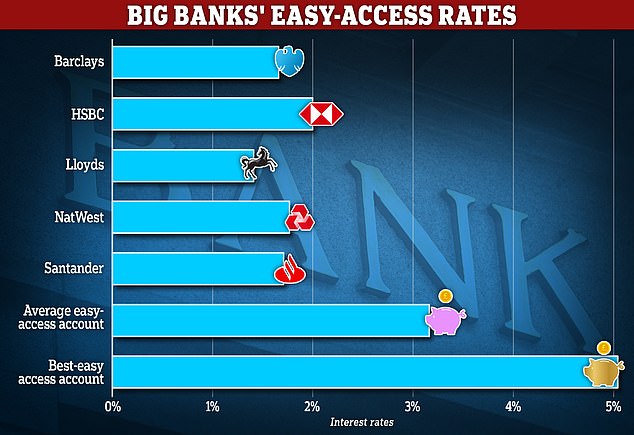The UK’s five biggest banks are still failing to offer competitive savings interest despite the Financial Conduct Authority’s Consumer Duty rules introduced last summer, new figures reveal.
Barclays, HSBC, Lloyds, Santander and NatWest are continuing to offer easy access savings rates well below the market average, new figures from rate monitor Moneyfacts Compare reveal.
There is still a staggering gap between the main market accounts, often offered by smaller banks and building societies, and the easy access rates of the big banks.
The five banks continue to offer savers easy-access accounts paying less than 2 percent.

Poor performers: The big five banks lag behind the market average when it comes to the interest they pay savers for easy access accounts
On £10,000 of savings, Moneyfacts figures show that five of the UK’s biggest banks’ easy-access flexible accounts pay an average interest rate of just 1.69 per cent, lagging behind the market average for an easy-access account easily with 1.43 percentage points.
Lloyds Bank is the weakest performer, adding just 1.4 per cent to cash savers dipping into its easy access deal, or £1.40 for every £100 saved.
HSBC’s Flexible Saver pays 1.98 per cent, while NatWest pays 1.74 per cent. Santander’s easy access deal pays 1.7 per cent, while Barclays’ pays 1.65 per cent.
This is despite the average easy access rate being 3.12 per cent according to Moneyfacts. The best easy access account pays 5.1 percent.
It comes as the FCA implements its new Consumer Obligations rules, which require banks and building societies to offer ‘fair value’ to savers.
James Hyde, spokesman at Moneyfacts Compare, said: “The consumer obligations rules in relation to existing products have been in place since 31 July 2023, meaning companies have had almost a year to review any previously non-competitive products and to bring them in accordance with the rules established by the Financial Conduct Authority.
“Unfortunately, the big five banks are still paying variable savings rates significantly below the rate. Their most accessible no-notice accounts all offer less than 2 per cent interest per annum – putting them all in the bottom fifth of the market.
“Currently, a saver putting £10,000 into an Easy Access Isa offered by a major bank would lose £169 in interest each year (compared to the average market rate paid), or £344 (in an account market leader) .’
Banks are making more money with their money
Over 80 per cent of accounts on the market currently pay 2 per cent or more on a £10,000 balance, according to Moneyfacts Compare.
This is Money analyzed these banks’ easy access rates in November and found they paid savers an average easy access rate of 1.85 per cent, so the average rate paid among them is now lower than in November 2023.
Lloyds’ easy savings rate of 1.4 per cent is unchanged from November 2023. NatWest’s easy access rate remains unchanged, as does Barclay’s and HSBC, while Santander’s was 2.5 per cent in November and now it is 1.7 percent.
Last month, figures from the Treasury Committee revealed that NatWest, Barclays, Lloyds and Santander received more than £9bn of interest on Bank of England reserves in 2023 – a 135 per cent increase on last year.
Under quantitative easing, the Bank of England created £895bn of new money in the form of central bank reserves held by commercial banks, of which around £700bn remains in circulation.
The bank pays interest on these reserves at the bank rate, currently 5.25 percent. This has generated significant income for banks as a result of the sharp rise in interest rates from 2021.
What do bank chiefs say?
Last month, the bosses of four big banks were asked by the Treasury Committee to outline the steps they had taken to offer better savings rates to customers.
Vim Maru, CEO of Barclays UK said: “Our pass rate is regularly assessed as part of pricing governance and has increased with bank rate increases.
‘Our range of products offer different interest rates for different savings goals, including our Rainy Day Saver (5.12 per cent up to £5,000) which encourages customers to build a savings habit whilst maintaining immediate access to cash Theirs.’
Charlie Nunn, chief executive of Lloyds Banking Group, said: “We already offer savings products with competitive rates of up to 4.25 per cent on instant access, up to 5.10 per cent on fixed rate accounts and up to 6.25 per cent on monthly accounts savings.
“We also constantly evaluate all our accounts to ensure they offer fair value, and in doing so we consider the wide range of features and benefits customers are looking for before choosing a particular account type.”
Paul Thwait, group CEO of NatWest said: “When you take a rounded view of our products, we offer competitive rates on savings products: 6 per cent plus on our regular Digital Saver, our fixed term accounts currently pay up to 4.60 percent for one year or 4.20 percent for 2 years [fixed rate Isa rates]and we’re paying up to 3.3 per cent on our instant access savings products.’
Mike Reigner, CEO of Santander UK said: “Since Bank Rate started to rise, we have significantly increased the amount we have paid our savers across our range. In 2022 we paid £195m in interest to customers on our range of savings products, but in 2023 we paid £1,399m.
“We have done this in a way that we believe is fair, adheres to the Consumer Duty and allows us to compete for new business through flexible pricing in our retail rates.”
What to do if you’re getting 2% or less in savings
Many savers remain loyal to the big banks despite the low rates they offer easy access.
The best easy-access accounts pay 5 percent or more, so if your savings are getting a much lower rate than that, you should consider moving your money elsewhere.
> See easy access savings rates for the best buy using This is Money charts.
Savers can find a 5.1 percent Easy Access account with Chase Bank, while Oxbury Bank offers 5.02 percent on Easy Access Savings.
James Hyde said: ‘Customers should proactively monitor savings rates, especially if they are on a variable rate which providers can adjust on a very reactive basis.
‘Be prepared to move on if you feel your loyalty is not being adequately rewarded.’
Some links in this article may be affiliate links. If you click on them, we may earn a small commission. This helps us fund This Is Money and keep it free to use. We do not write articles to promote products. We do not allow any commercial relationship to affect our editorial independence.

